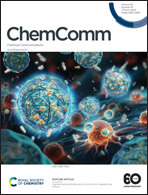Visible light-induced C(sp3)–H azolation of ethers via radical-polar crossover†
Abstract
Reported herein is a photochemical strategy for C(sp3)–H azolation of ethers via a hydrogen-atom transfer and radical-polar crossover process, offering efficient access to valuable N-alkylated azoles under visible-light irradiation. The protocol is metal-free and photocatalyst-free, and exhibits good to excellent yields and broad substrate scope with regard to azoles. EPR experiments provide evidence for the formation of intermediates formed in situ.



 Please wait while we load your content...
Please wait while we load your content...